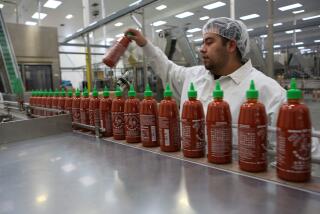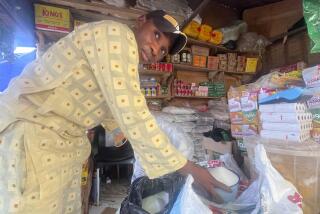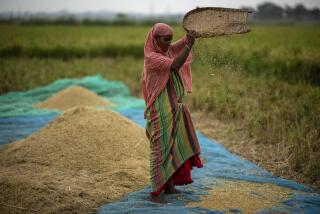Global run on rice hits stores in U.S.
- Share via
The global run on food that has led to shortages and riots in Egypt, Haiti and other nations has made its way to U.S. shores.
Concerned about rising prices and limited supplies of staples such as rice and flour, customers across the country have been cleaning out the shelves at big-box retailers, including Wal-Mart Stores Inc.’s Sam’s Club and Costco Wholesale Corp. stores.
On Wednesday, Sam’s Club said customers would no longer be allowed to purchase more than four bags of jasmine, basmati or long-grain white rice on each visit.
Sam’s Club blamed the restriction on “supply and demand trends” and said it was working with suppliers “to ensure we are in stock.”
The policy involves only bags weighing 20 pounds or more and does not affect smaller packages sold at the store or its sister Wal-Mart outlets.
This week, Costco said it had seen sales of flour, rice and some cooking oils leap. Some Costco stores already have held customers to just two bags of rice a day, but the chain doesn’t plan to limit sales nationwide.
By midafternoon Wednesday, the Costco in Alhambra -- which had not placed limits on purchases -- said it had run out of rice.
Earlier in the day, Michael Yang, manager of Hawaiian barbecue restaurants in Pico Rivera and West Covina, had decided it was time to stock up. He bought 46 bags of medium-grain rice, 50 pounds each, at the Alhambra Costco and loaded them into his white van.
He paid $15.39 each, which he called a bargain compared with premium brands from Thailand that have recently nearly doubled in price to $40 for a 50-pound bag.
“The price of everything -- oil, sugar -- has been going up for months, and rice has been an issue for a few weeks already. Everyone else is doing the same thing I am because they use up their rice so fast,” Yang said in Mandarin.
Prices for many foods, including beer, bread, coffee, pizza and rice, are rising rapidly as the nation contends with its worst bout of food inflation since 1990. The cost of groceries is climbing at an annual rate of about 5% this year.
Retail experts said there was little evidence of “panic” hoarding by the public. It appears that restaurants and smaller retailers have been buying up most of the stock on the expectation that prices will continue to rise.
Still, shoppers’ actions have taken some stores by surprise.
“It is like a run on the bank. We don’t think there is a shortage, it is just increased shopping by customers who think there is,” said Richard Galanti, Costco’s chief financial officer. For now, the retailer is allowing managers of stores with short supplies to set their own rules.
Other retailers report adequate supplies.
“Ralphs has plenty of rice. No shortages at any of our stores,” said Terry O’Neil, spokesman for Ralphs Grocery Co.
When Heidi Diep visited the Costco in Alhambra last week seeking rice for her Chinese fast-food restaurant in Silver Lake, the store was out of stock. It had plenty of rice when Diep went back Wednesday, but, thanks to shoppers like Diep and Yang, ran out again.
“I picked up as much as I could,” Diep said as she hauled a dozen 50-pound bags of Super Lucky Elephant rice and 10 bags of 25-pound long grain into her van and her sister’s sedan.
The businesswoman said she was stockpiling the grain to avoid future price increases and a repeat of the week when it couldn’t be found.
Internationally, shortages of basic commodities -- including rice, wheat and some oils -- have led to protests and riots in recent months, prompting concern about food security in many poor countries.
With the exception of rising prices, the U.S. has escaped the problems seen in other countries. Some brewers have complained of shortages of certain types of hops for making high-end beers, and bakers have scrambled to find some specialty flours.
If the shortages expand to other food products that can be easily stored, the U.S. economy may take a hit.
Runs on staples such as rice have consequences for the larger economy by adding to inflation and making it harder for the Federal Reserve to cut interest rates to ease problems in the financial and housing markets, said Milton Ezrati, an economist at investment firm Lord, Abbett & Co. in Jersey City, N.J.
The U.S. run on rice is mostly a consumer reaction to international headlines combined with domestic food inflation that turns into a self-fulfilling prophecy, Ezrati said.
The futures-market price of U.S.-grown long-grain rice -- the type that is in short supply worldwide -- has risen 73% this year to $24.82 for 100 pounds as other countries shut off exports.
More heavy purchasing of rice will just move American inventory from warehouses and store shelves into cupboards or the storerooms of restaurants, putting pressure on supplies and prices and “compounding the problem,” Ezrati said.
Since the fall, large producers such as Vietnam, India and Egypt have banned or limited rice exports to keep a lid on domestic food prices. China, another major producer, has taxed rice exports.
But there is no dearth of rice in the United States. The Department of Agriculture projects U.S. rice supplies this year will be 8.3 million tons, nearly unchanged for the last seven years. Because Americans consume just 10% to 15% of what people in Asia’s big rice-eating nations eat, there’s plenty for domestic use, said Nathan Childs, a USDA market analyst. Rice consumption in the U.S. is so low that as much as half of the domestic crop is exported.
Most rice is eaten within 100 miles of where it is grown. Just 8% of world production actually trades internationally, Childs said. So these new export limits and taxes have had an outsize effect on prices, he said.
That’s made for a rough time for Thomas Chan, manager of the ABC Cafe in Monterey Park. At least 70% of his customers order rice.
The cafe now purchases 100 large bags of rice each month as backup, Chan said. “Without a steady supply, what do we have to give to customers?”
--
tiffany.hsu@latimes.com
--
Begin text of infobox
A food that sustains half the world
Soaring prices for rice, a staple for more than half the world’s population, are leading to shortages, government protection of domestic stocks and even political unrest in some poorer countries.
* Most of the 3 billion-plus people for whom rice is a staple are in Asia. But it is also an essential food in parts of Africa and the Caribbean.
* About 645 million tons of rice was grown in 114 countries in 2007. Rocketing prices have caused several countries to ban or restrict exports, as growing appetites in China and India, drought in Australia and pests in Vietnam add to fears that millions of people may be cut off.
* Thailand, which ships one-third of the world’s rice exports, may follow its Asian neighbors in limiting sales. That would further tighten supplies and send prices higher.
* There’s no shortage of rice in the United States. The nation exports as much as half of its crop each year.
* A member of the grass family, rice was first farmed about 10,000 years ago. Thought to be native to deltas around the Ganges, Yangtze, Tigris and Euphrates rivers, rice now grows on every continent except Antarctica. As well as being cooked, the grain is processed to make cakes, wine, flour and vinegar.
--
Times research and Reuters
More to Read
Inside the business of entertainment
The Wide Shot brings you news, analysis and insights on everything from streaming wars to production — and what it all means for the future.
You may occasionally receive promotional content from the Los Angeles Times.












